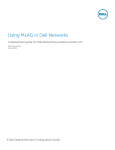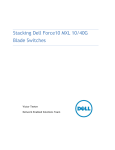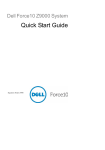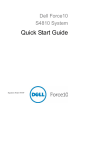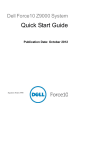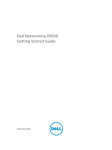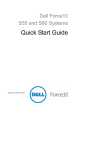Download Dell Force10 MXL Specifications
Transcript
Dell Networking MXL 10/
40GbE Switch IO Module
Getting Started Guide
March 2014
Regulatory Model: DF10MXL
Notes, Cautions, and Warnings
NOTE: A NOTE indicates important information that helps you make better use of
your device.
CAUTION: A CAUTION indicates potential damage to hardware or loss of data if
instructions are not followed.
WARNING: A WARNING indicates a potential for property damage, personal
injury, or death.
____________________
Information in this publication is subject to change without notice.
Copyright © 2014 Dell Inc. All rights reserved. This product is protected by U.S. and international
copyright and intellectual property laws. Dell and the Dell logo are trademarks of Dell Inc. in the
United States and/or other jurisdictions. All other marks and names mentioned herein may be
trademarks of their respective companies.
Regulatory Model DF10MXL
March 2014 P/N WMDP6
Rev. A02
Contents
1
Introduction .
2
Product Description
. . . . . . . . . . . . . . . . .
7
3
Hardware Overview .
. . . . . . . . . . . . . . . . .
8
. . . . . . . . . . . . . . . . . . . . . . .
8
. . . . . . . . . . . . . . . . . . . . . . . .
8
Internal Ports.
Front Panel .
Base Module .
. . . . . . . . . . . . . . . . . . . . . . .
. . . . . . . . . . . . . . . . . . . . . . .
FlexIOTM Plug-in Modules .
Port Numbering
USB Ports
. . . . . . . . . . . . . . . .
7
9
9
. . . . . . . . . . . . . . . . . . . . .
12
. . . . . . . . . . . . . . . . . . . . . . . .
13
. . . . . . . . . . . . . . . . . .
14
. . . . . . . . . . . . . . . . . . . . . . .
16
System and Port LEDs
Installation .
Site Preparation
. . . . . . . . . . . . . . . . . .
16
Unpacking the Switch .
. . . . . . . . . . . . . . . . .
17
Package Contents
. . . . . . . . . . . . . . . . .
17
. . . . . . . . . . . . . . . . . .
17
Unpacking Steps
Contents
3
4
Installing and Configuring the Switch .
Installing the Switch Blade in a PowerEdge M1000e .
Connecting a Console Terminal
.
19
. . . . . . . . . . . . .
21
. . . . . . . .
22
Performing the Initial Configuration .
. . . . . . . . . .
22
Initial Configuration Procedure .
. . . . . . . . . .
23
Invoking the X-Loader and U-Boot CLIs .
5
Assembling a Switch Stack .
Configuring and Bringing Up a Stack
Managing a Stack
Stack Startup
. . . . . . . . .
25
. . . . . . . . . .
26
. . . . . . . . . . . . . . . . . . . .
28
. . . . . . . . . .
28
. . . . . . . . . . . . . . . . . . . .
28
Master and Member Switches .
6
Splitting 40GbE QSFP+ Ports into 10GbE SFP+
Ports . . . . . . . . . . . . . . . . . . . . . . . . . . . . 30
7
Switch Configuration .
DCB Support
iSCSI Operation
Contents
. . . . . . . . . . . . . .
. . . . . . . . . . . . . . . . . . . . . . .
31
32
. . . . . . . . . . . . . . . . . . . .
32
. . . . . . . . . . . . . . . . . . . . .
32
FCoE Connectivity
4
17
.
8
Next Steps .
9
Technical Specifications .
. . . . . . . . . . . . . . . . . . . . . . .
Chassis Physical Design
. . . . . . . . . . . .
34
. . . . . . . . . . . . . . . .
34
Environmental Parameters
. . . . . . . . . . . . . . .
34
. . . . . . . . . . . . . . . . . .
35
. . . . . . . . . . . . . . . . . . . . .
35
Power Requirements
IEEE Standards .
33
Contents
5
6
Contents
Introduction
This document provides basic information about the Dell Networking MXL
10/40GbE Switch IO Module, including how to install the switch in the Dell
PowerEdge M1000e Enclosure and perform the initial configuration.
For more detailed information about any of the basic installation steps, refer to
the Dell PowerEdge M1000e Enclosure Owner's Manual on the Dell Support
website at http://support.dell.com/manuals.
Product Description
The MXL 10/40GbE Switch is a layer 2/3 blade switch with two fixed 40GbE
ports on the base module and support for two optional plug-in modules. The
switch operates in a PowerEdge M1000e Enclosure, which can support up to
32 servers and six MXL 10/40GbE Switches.
The MXL 10/40GbE Switch runs the Dell Networking operating system (OS),
providing switching, bridging, and routing functionality for transmitting data,
storage, and server traffic as follows:
•
GbE/10GbE connections through the midplane to up to 32 server ports in
the chassis
•
GbE, 10GbE, or 40GbE connections through uplink ports to top-of-rack
(ToR) switches
•
40GbE stacking connections to other MXL 10/40GbE Switches in a
switch stack
In a data center network, the MXL 10/40GbE Switch provides converged
network support and interoperates with Dell and third-party ToR devices.
The switch supports data center bridging (DCB) features, and optimizes
connectivity between servers and storage devices over Fiber Channel over
Ethernet (FCoE) and internet small computer system interface (iSCSI) links.
By providing increased 40GbE bandwidth for device interconnection in a
shared network storage environment, with the possibility of splitting 40GbE
quad small form-factor pluggable plus (QSFP+) uplinks into 10GbE small
form-factor pluggable plus (SFP+) connections, the MXL 10/40GbE Switch
is perfectly positioned to help transition a data center with multiple speed
requirements.
Introduction
7
Hardware Overview
This section contains information about device characteristics and modular
hardware configurations for the MXL 10/40GbE Switch.
Internal Ports
The MXL 10/40GbE Switch provides thirty-two 1/10-Gigabit Ethernet
internal ports. The internal ports are connected to server blades through the
M1000e chassis midplane. Each port can operate in either 1GbE or 10GbE
mode. Internal ports are numbered 1 to 32.
The MXL 10/40GbE Switch also provides an internal Ethernet interface—the
out-of-band (OOB) interface—which is dedicated to switch management.
The OOB interface is connected to the chassis management controller
(CMC) through the chassis midplane. Traffic on this port is segregated from
operational network traffic on the switch ports and cannot be switched or
routed to the operational network.
Front Panel
Figure 1-1 shows the MXL 10/40GbE Switch front panel:
Figure 1-1. MXL 10/40GbE Switch: Front Panel l
Expansion Slot 1
Expansion Slot 0
USB Console Port
40GbE QSFP+ Ports
8
Hardware Overview
Base Module
The MXL 10/40GbE Switch provides two native 40-Gigabit Ethernet fixed ports
on the base module for uplink connections. You can use these ports with 4x10G
breakout cables to operate as 10GbE uplink ports.
In addition, you can configure the native 40GbE ports as stacking ports. You
can connect up to six MXL 10/40GbE Switches (in the same or different
chassis) in a single stack. For more information, refer to Assembling a Switch
Stack.
FlexIOTM Plug-in Modules
The MXL 10/40GbE Switch (Figure 1-2) provides 10/40GbE external
connectivity by using the following FlexIO plug-in modules in the two
expansion slots:
•
4-Port 10-Gigabit Ethernet module using SFP+ optics (SR or LR) or
direct-attach cables (1m, 3m, or 5m DAC)
•
4-Port 10GBASE-T module using RJ-45 connector (copper) cables
NOTE: The 10Mb speed is not supported on the 4-Port 10GBASE-T module.
Only 100Mb, 1GbE, and 10GbE speeds are supported.
•
2-Port 40-Gigabit Ethernet QSFP+ module which you can use for 40GbE
connections or 10GbE SFP+ connections using 4x10G breakout cables.
By default, the 40GbE ports on a 2-Port 40GbE QSFP+ module come up
in 4x10GbE (quad) mode as eight 10GbE ports. To change a port from
4x10GbE to 40GbE mode of operation, enter the no stack-unit port
portmode quad command.
Dell(conf)# no stack-unit unit-number port port-number
portmode quad
stack-unit unit-number: Enter the number of the stack unit to
be reset. The range is from 0 to 5. To display the stack-unit number,
enter the show system brief command.
port port-number: Enter the port number of the 40GbE QSFP+
port to be split. Valid values for slot 0: 41 or 45; for slot 1: 49 or 53
(refer to Port Numbering).
portmode quad: Identifies the port as a split 10GbE SFP+ port.
Hardware Overview
9
Save the configuration and reload the switch.
Dell# write memory
Dell# reload
•
Up to two FC Flex IO modules can be inserted on an I/O Aggregator,
thereby enabling up to 32G of FC throughput per module or 64G
throughput per switch. All the ports support 2/4/8G FC and SFP+ optics.
The FC Flex IO modules provide flexibility for pairing with the other
FlexIO modules. The two FC Flex IO modules that offer up to 8 8Gb
Fibre Channel ports for uplink traffic in addition to the fixed two 40GbE
ports on the MXL 10/40GbE Switch and I/O Aggregator.
Figure 1-2. MXL 10/40GbE Switch: Plug-in Modules
2-Port 40GbE QSFP+ Module
4-Port 10GbE SFP+ Module
4-Port 10GBASE-T Module (100Mb/1GbE/10GbE)
10
Hardware Overview
Figure 1-3. FC FlexIO Modules
NOTE: You can only hot-swap plug-in modules of the same type without requiring a
reboot. For example, you can replace a 2-Port 40GbE QSFP+ module only with
another 2-Port 40GbE QSFP+ module.
On the MXL 10/40GbE Switch, you can configure uplink ports of the same
speed on different modules in the same link aggregation group (LAG). You
can also use individual ports for uplink connections.
NOTE: A maximum of 16 ports are supported in a LAG.
For switch stacking, you must use a 40GbE port on the base module or on a
2-Port 40GbE QSFP+ plug-in module. Stacking is not supported on 10GbE
ports.
All FlexIO plug-in modules, transceivers, and attach cables are sold separately.
Hardware Overview
11
Port Numbering
When installed in a PowerEdge M1000e Enclosure, the MXL 10/40GbE
Switch ports are numbered 33 to 56 from the bottom to the top of the switch:
•
40GbE base-module ports:
•
In 40GbE mode of operation, the ports are numbered 33 and 37.
•
In 4x10GbE mode of operation, the ports are numbered 33 to 36
and 37 to 40.
For information about how to change a 40GbE port to 4x10GbE mode,
refer to Splitting 40GbE QSFP+ Ports into 10GbE SFP+ Ports.
•
2-Port 40-GbE QSFP+ module operating in the default 4x10GbE mode:
•
In expansion slot 0, the ports are numbered 41 to 44 and 45 to 48.
•
In expansion slot 1, the ports are numbered 49 to 52 and 53 to 56.
For information about how to change a port from 4x10GbE to 40GbE
mode of operation, refer to FlexIOTM Plug-in Modules.
•
•
•
12
2-Port 40-GbE QSFP+ module operating in 40GbE mode:
•
In expansion slot 0, the ports are numbered 41 and 45.
•
In expansion slot 1, the ports are numbered 49 and 53.
4-Port 10-GbE SFP+ or 10GBASE-T module:
•
In expansion slot 0, the ports are numbered 41 to 44.
•
In expansion slot 1, the ports are numbered 49 to 52.
The FC Flex IO modules ports operate:
•
In expansion slot 0, the ports are numbered 41 to 44.•
•
In expansion slot 1, the ports are numbered 49 to 52.
Hardware Overview
USB Ports
Figure 1-4. USB Ports on Front Panel
USB Storage Port
USB Console Port
To configure the switch through an RS-232 serial interface, use the lower USB
console port (Figure 1-4). This port provides a direct connection to the switch
and allows you to access the command line interface (CLI) from a console
terminal connected to the port through the provided serial cable (with USB
type-A to female DB-9 connectors).
The console port supports asynchronous data of eight data bits, one stop bit,
no parity bit, and no flow control. The default baud rate is 9600 bps.
The upper USB port functions as an external flash drive that you can use to
store configuration files and scripts.
Hardware Overview
13
System and Port LEDs
The front panel of the MXL 10/40GbE Switch contains light emitting diodes
(LEDs) that provide information about the status of the switch (Figure 1-5).
Figure 1-5. System LEDs on Front Panel
40GbE Ports
System Status LED
System Power LED
Table 1-1 describes system LED conditions.
Ta b l e 1 - 1 .
System LEDs
System LED
Color
Meaning
Green
Power is being supplied to the switch.
Off
The switch does not have power.
Blue
The switch is operating normally as a standalone
switch or as a stack master.
Off
The switch is not the stack master.
Amber
A fault has occurred or the switch is booting.
Power
Status
Each plug-in module also contains LEDs that provide information about the
link status and traffic activity on a port (Figure 1-6).
14
Hardware Overview
Figure 1-6. Port LEDs on Modules
Link Status
Activity
Link Status
Activity
Link Status
Activity
Table 1-2 describes the LED status of the 10GbE BASE-T, 10GbE SFP+, and
40GbE QSFP+ ports.
Ta b l e 1 - 2 .
Port LED Status
Port LED
Color
Meaning
Off
The port is down.
Green
The port is up and can transmit traffic at maximum
speed:
A QSFP+ port can transmit at 40G.
An SFP+ port can transmit at 10G.
A BASE-T port can transmit at 10G.
Yellow
The port is up and is transmitting traffic at lower than
maximum speed:
A 40GbE QSFP+ port is transmitting at 10G.
A 10GbE SFP+ or 10GBASE-T port is transmitting at
1G or 100Mb.
Off
No traffic is being transmitted or received on the port.
Blinking
Green
Traffic is being transmitted or received on the port.
Link Status
Activity
Hardware Overview
15
Table 1-3 describes the LED status of a 40GbE QSFP+ port that is split into
four 10GbE SFP+ ports using a 4x10G breakout cable.
Ta b l e 1 - 3 .
Cable
LED Status of a 40GbE QSFP+ Port with Breakout
Port LED
Color
Meaning
Off
All four 10GbE ports on a breakout cable are down.
Yellow
At least one of the four 10GbE ports on a breakout
cable is up.
Off
No traffic is being transmitted on any 10GbE port on
the breakout cable.
Blinking
Green
Traffic is being transmitted or received on at least one
of the 10GbE ports on the breakout cable.
Link Status
Activity
Installation
Site Preparation
Before installing the switch or switches, make sure that the chosen
installation location meets the following site requirements:
•
Clearance — There is adequate front and rear clearance for operator
access. Allow clearance for cabling, power connections, and ventilation.
•
Cabling — The cabling is routed to avoid sources of electrical noise such
as radio transmitters, broadcast amplifiers, power lines, and fluorescent
lighting fixtures.
•
Ambient Temperature — The ambient switch operating temperature
range is 10° to 35ºC (50° to 95ºF).
NOTE: Decrease the maximum temperature by 1°C (1.8°F) per 300 m (985 ft.)
above 900 m (2955 ft.).
•
16
Relative Humidity — The operating relative humidity is 8% to 85%
(non-condensing) with a maximum humidity gradation of 10% per hour.
Hardware Overview
Unpacking the Switch
Package Contents
When unpacking each switch, make sure that the following items are
included:
•
One Dell Networking MXL 10/40GbE Switch IO Module
•
One USB type A-to-DB-9 female cable
•
Getting Started Guide
•
Safety and Regulatory Information
•
Warranty and Support Information
•
Software License Agreement
Unpacking Steps
NOTE: Before unpacking the switch, inspect the container and immediately report any
evidence of damage.
1 Place the container on a clean, flat surface and cut all straps securing the
container.
2 Open the container or remove the container top.
3 Carefully remove the switch from the container and place it on a secure
and clean surface.
4 Remove all packing material.
5 Inspect the product and accessories for damage.
Installing and Configuring the
Switch
After you unpack the MXL 10/40GbE Switch, refer to the flow chart in
Figure 1-7 for an overview of the steps you must follow to install the blade
and perform the initial configuration.
To see if a switch is running the latest Dell Networking OS version, use the show
version command. To download an Dell Networking OS version, go to
http://support.dell.com.
Installing and Configuring the Switch
17
Figure 1-7. MXL 10/40GbE Switch: Installation and Configuration Flow Chart
Insert Switch Blade
and Power On
Connect Console
Press
any key to
enter X-Loader
or U-Boot
menu?
Yes
X-Loader CLI
No
Run Memory Tests/
Configure Switch
Settings
Yes
U-Boot CLI
No
Reboot
Do not press a key
Do not press a key
Load Image
from Flash to RAM
Enter
Wizard?
Yes
No
To exit Jumpstart:
From the console, enter
FTOS> enable
FTOS# stop jumpstart
FTOS# reload-type normal
Jumpstart waits for
DHCP Offer with
FTOS Image and
Configuration
Manual Initial
Configuration
18
Installing and Configuring the Switch
Assemble a
Switch Stack
Easy Setup Wizard
Configuration
Switch
Configuration
Installing the Switch Blade in a PowerEdge
M1000e
After you unpack the switch blade, slide it into one of the open I/O module
slots in the back of a PowerEdge M1000e.
The M1000e is a 10U rack-mountable blade chassis that holds:
•
Server blades: Eight full-height, 16 half-height, or 32 quarter-height blades
•
Switch blades: Six I/O modules and two integrated chassis management
controllers
Server blades are installed in the front of the chassis (Figure 1-8); switch
blades are installed in the back of the chassis (Figure 1-9).
Figure 1-8. PowerEdge M1000e: Front View with Server Blades
16 half-height
server blades
Installing and Configuring the Switch
19
Figure 1-9. PowerEdge M1000e: Back View with Six MXL 10/40GbE Switch Blades
After you slide the MXL 10/40GbE Switch in so that the connectors on the
back of the blade touch the chassis midplane, the switch receives power from
the chassis and automatically powers on. The chassis management controller
(CMC) in the chassis validates that the switch blade is a supported I/O
module before powering it on.
When the switch powers on, the Boot loader loads the image from the local
flash. The image initializes the hardware and brings the switch up in
operational mode.
20
Installing and Configuring the Switch
Connecting a Console Terminal
After the MXL 10/40GbE Switch powers on, complete all external cabling
connections and connect a terminal to the blade to configure the switch.
NOTE: If you are installing a stack of MXL 10/40GbE Switches, connect the terminal
to the console port on the Master Switch. If you connect the terminal to a member
(non-Master) switch, you will not be able to use the CLI. For more information, refer
to Assembling a Switch Stack.
Read the Release Notes for this product before proceeding. You can download the
release notes from the Dell Support website at support.dell.com/manuals.
To monitor and configure the switch via the serial console, use the USB
console port on the front panel of the switch (Figure 1-4) to connect it to a
VT100 terminal or to a computer running VT100 terminal emulation
software. The console port is implemented as a data terminal equipment
(DTE) connector.
The following equipment is required to use the console port:
•
VT100-compatible terminal or a desktop or a portable computer with a
serial port running VT100 terminal emulation software, such as Microsoft
HyperTerminal.
•
A serial cable (provided) with a USB type-A connector for the console port
and DB-9 connector for the terminal.
To connect a terminal to the switch console port, perform the following tasks:
1 Connect the DB-9 connector on the serial cable to the terminal or
computer running VT100 terminal emulation software.
2 Configure the terminal emulation software as follows:
a
Select the appropriate serial port (for example, COM 1) to connect to
the console.
b
Set the data rate to 9600 baud.
c
Set the data format to 8 data bits, 1 stop bit, and no parity.
d
Set the flow control to none.
e
Set the terminal emulation mode to VT100.
f
Select Terminal keys for Function, Arrow, and Ctrl keys. Ensure that
the setting is for Terminal keys (not Microsoft Windows keys).
Installing and Configuring the Switch
21
Connect the USB connector on the cable directly to the switch console port.
The console port on the MXL 10/40GbE Switch is located below the fixed
40GbE ports (Figure 1-4).
Invoking the X-Loader and U-Boot CLIs
During the boot process, you can perform various configuration tasks by
accessing the X-Loader and U-Boot CLIs, such as running memory tests
(X-Loader) and activating the backup image or recovering a password
(U-Boot).
You are first prompted to enter the X-Loader CLI by pressing any key when
the following message displays: Hit any key to stop autoboot. If
you do not press a key, the boot process continues and you are prompted to
enter the U-Boot CLI by pressing any key.
After performing any of the X-Loader or U-Boot tasks, the switch
automatically reboots when you exit a CLI. To continue with the boot process
without entering either CLI, do not press a key.
Performing the Initial Configuration
Prerequisites: Before you perform the initial switch configuration, make sure
that:
•
The MXL 10/40GbE Switch was never configured before and is in the
same state as when you received it.
•
The MXL 10/40GbE Switch booted successfully when it powered on.
Perform the initial switch configuration through the console port. After the
initial configuration, you can manage the switch from the already connected
console port or through a remote connection.
Before you start, to perform the initial switch configuration, you must obtain
the following information from your network administrator:
22
•
The IP address to be assigned to the out-of-band (OOB) interface for
device management.
•
The IP subnet mask for the OOB interface.
•
The IP address of the OOB interface default gateway.
Installing and Configuring the Switch
These settings are necessary to allow remote management of the switch
through a Telnet (Telnet client) or HTTP (Web browser) connection.
NOTE: The switch is configured with a default user name (root) and password
(calvin).
Initial Configuration Procedure
Perform the initial configuration from the connected console by using the
CLI.
Configuring the SNMP Server
To set up the SNMP account and provide read/write privileges, use the snmpserver community command.
1 Create an SNMP community string with read/write privileges by entering the
snmp-server community <community_name> rw <ACL_NAME> command in
CONFIGURATION mode.
2 Enter IP ACCESS LIST mode by naming a standard IP access list by entering the
ip access-list standard <ACL_NAME> in CONFIGURATION mode.
3 Configure the management IP address to manage the SNMP query of
the chassis by entering the permit <Management_System_IP> command in
CONFIGURATION-IP ACCESS-LIST-STANDARD mode.
With this configuration, the SNMP query is accepted only from the
configured IP.
NOTE: If you want any SNMP management entity to access the chassis, ignore
steps 2 and 3.
Configuring the Username and Password
To access the system remotely, configure a system username, password, and
privilege level.
1 Configure a username, password, and privilege level by entering the username
username password <LINE> privilege level command in CONFIGURATION
mode.
Installing and Configuring the Switch
23
Configuring the Management Port IP Address
Assign IP addresses to the management ports in order to access the system
remotely.
1 Enter INTERFACE mode for the Management port by entering the interface
ManagementEthernet slot/port command in CONFIGURATION mode.
2 Assign an IP address to the interface by entering the ip address ip-address/mask in
INTERFACE mode.
3 Enable the interface by entering the no shutdown command in INTERFACE
mode.
Configuring the Default VLAN IP Address
Assign IP addresses to the default VLAN in order to access the system remotely.
1 Enter INTERFACE mode for the VLAN by entering the interface vlan 1 command
in CONFIGURATION mode.
2 Assign an IP address to the interface by entering the ip address ip-address/mask in
INTERFACE mode.
3 Enable the interface by entering the no shutdown command in INTERFACE
mode.
Configuring the Management Route
Define a path from the MXL switch to the network from which you are
accessing the MXL remotely. Management routes are separate from IP routes
and are used to manage the MXL switch through the management port.
1 Configure a management route to the network from which you are accessing the
system by entering the management route ip-address/mask gateway command in
CONFIGURATION mode.
For more information about how to perform the initial configuration using
the CLI, refer to the Dell Networking OS Configuration Guide for the Dell
Networking MXL 10/40GbE Switch IO Module.
24
Installing and Configuring the Switch
Assembling a Switch Stack
After you complete the initial switch configuration, the MXL 10/40GbE
Switch is powered up and operational. Stacking is supported on the 40GbE
ports on the base module or a 2-Port 40GbE QSFP+ module to connect up
to six MXL 10/40GbE Switches in a single stack.
Figure 1-10 shows an example using six MXL 10/40GbE Switches in a chassis.
The MXL 10/40GbE Switches are connected to operate as a single stack in a
ring topology using only the 40GbE ports on the base modules. You can use
the 40GbE ports on the base module and plug-in modules to create a stack in
either a ring or daisy-chain topology.
NOTE: Power up all MXL 10/40GbE Switches in the stack should be powered up
with the initial configuration before you attach the cables.
Figure 1-10. Six Stacked MXL 10/40GbE Switches
Assembling a Switch Stack
25
Use only QSFP transceivers and QSFP cables (separately purchased) to
connect stacking ports as follows:
1 Insert a QSFP cable in the bottom stacking port on the rightmost switch.
2 Connect the upper stacking port on the next switch to the left.
3 Continue connecting each switch to the next in this way until you reach
the leftmost switch in the stack.
4 On the leftmost switch, connect the bottom stacking port to the upper
stacking port on the rightmost switch to create a loop.
NOTE: The resulting ring topology allows the entire stack to function as a single
switch with resilient fail-over capabilities.
If you do not connect the leftmost switch to the rightmost switch (Step 4), the stack
operates in a daisy-chain topology with less resiliency. Any failure in a non-edge
stack unit causes a split stack.
Configuring and Bringing Up a Stack
NOTE: Although stacking is supported on 40GbE ports on the base module or a
2-Port 40GbE QSFP+ module, this section shows how to configure stacking only on
the base-module ports (Figure 1-10).
To convert the 40GbE ports on the 2-Port QSFP+ module from their default 4x10GbE
mode to 40GbE mode to configure a stack, refer to FlexIOTM Plug-in Modules. After
the converting the ports to 40GbE, you do not have to reload the switch because a
switch reload is required as part of the stack configuration procedure.
After you attach the QSFP+ cables in a stack of MXL 10/40GbE Switches, to
configure and bring up the stack, follow these steps:
1 Connect the terminal to the console port on an MXL 10/40GbE Switch.
Enter the following commands to access the CLI and configure the two
40GbE ports on the base module for stacking mode:
Login: username
Password: *****
Dell> enable
Dell# configure
Dell(conf)# stack-unit 0 stack-group 0
Dell(conf)# stack-unit 0 stack-group 1
Where stack-unit 0 defines the default stack-unit number in the initial
configuration of a switch; stack-group 0 defines the stack group for the
26
Assembling a Switch Stack
lower 40GbE base-module port and stack-group 1 defines the stack group
for the upper 40GbE base-module port. To display the ports in each stack
group, enter the show system stack-unit unit-number stack-group command.
2 Save the stacking configuration on the 40GbE ports:
Dell# write memory
3 Repeat Steps 1 and 2 on each MXL 10/40GbE Switch in the stack by
entering the stack-unit 0 stack-group 0 and stack-unit 0 stack-group 1
commands and saving the configuration.
4 Reboot each switch by entering the reload command in EXEC Privilege
mode:
Dell# reload
If the stacked switches all reboot at approximately the same time, the
switch with the highest MAC address is automatically elected as the
Master Switch. The switch with the next highest MAC address is elected
as Standby Master.
To configure the stack so that the roles are assigned according to
pre-determined priorities, enter the stack-unit priority command as
described in the following Note.
To reload the stack, connect the terminal to the Master Switch and enter the
reload command in EXEC Privilege mode. If you connect the terminal to a
member (non-Master) switch, you will not be able to access the CLI.
To determine which switch is the Stack Master, enter the show system
command at the terminal.
To remove a port from stacking mode, use the no form of the stack-unit stackgroup command; for example, no stack-unit 0 stack-group 0. After entering the
command, save the configuration and reload the switch for the change to take
effect. When the reload completes, the port comes up in 40GbE mode if it is
on the base module and in 4x10GbE (quad) mode if the port is on a plug-in
module.
NOTE: You can manually configure the switch that will be Master by entering the
stack-unit unit-number priority number command in CONFIGURATION mode on
each stacked switch, where:
stack-unit unit-number identifies the switch in the stack.
priority number specifies the management priority. Range: 1-14. Default: 0.
Assembling a Switch Stack
27
The switch with the highest priority number is elected Master. The switch with the
next highest priority number is elected Standby Master and takes over stack
management if the Master Switch fails. For example:
Dell> enable
Dell# configure
Dell(conf)# stack-unit 0 priority 14
The no form of the stack-unit unit-number priority number command reverts the
management priority of a stack unit to the default value of 0.
Managing a Stack
Master and Member Switches
You can manage a stack of MXL 10/40GbE Switches as a single entity when
connected together. Manage the stack from the CLI through the serial
console connection or a remote Telnet session over the OOB management IP
address.
When you create a stack is created, one switch automatically becomes the
Master Switch and another switch is elected Standby Master. The Master
Switch maintains stack operation with minimal impact in the event of:
•
Switch failure
•
Inter-switch stacking link failure
•
Switch insertion
•
Switch removal
If the Master Switch goes off line, the Standby Master replaces it as the new
master and the switch with the next highest MAC address or priority becomes
Standby Master.
Stack Startup
Topology Discovery
When a stack is formed, a topology discovery process builds up a database
that contains information about all of the switches in the stack, including the
Dell Networking OS version, hardware version, management priority, and
switch MAC address. To view this information, use the show system
command.
28
Assembling a Switch Stack
Auto Stack Number Assignment
During the stack formation process, a unique stack-unit number is assigned if
the same number is assigned to more than one switch. After assignment is
complete, each switch saves its stack-unit number. To view stack-unit
numbers, enter the show system command.
Dell Networking OS Version Checking
Following the stack-unit number assignment, the Master Switch performs a
consistency check to make sure that all switches in the stack are running the
same Dell Networking OS version.
If the Master Switch determines that all switches are not running the same
Dell Networking OS version, the ports on switches with the incorrect version
are disabled.
To download the required Dell Networking OS image from the Master Switch
and reload a member switch so that it joins the stack, enter the following
command in EXEC Privilege mode:
Dell# upgrade system stack-unit unit-number partition
Where stack-unit unit-number identifies the switch whose Dell Networking
OS version needs to be upgraded; partition identifies the partition on the
Master Switch from which the Dell Networking OS image boots up. For
example:
Dell# upgrade system stack-unit 3 a:
To display the boot partition used on the Master Switch, enter the show
version command.
To ensure that a stack unit boots from partition a:, enter the commands:
Dell# configure
Dell(conf)# boot system stack-unit unit-number primary system
a:
Dell(conf)# end
Dell# write memory
Dell# power-cycle stack-unit unit-number
NOTE: When you stack an MXL 10/40GbE Switch, booting is supported only from
flash memory; it is not supported over the network via an IP address.
NOTE: To upgrade all switches in a stack with the same Dell Networking OS
version in a specified partition, enter the following command in EXEC Privilege
mode:
Dell# upgrade system {ftp: | tftp:} partition
Assembling a Switch Stack
29
This command uses an interactive CLI that requests the server IP address and
image filename, and prompts you to upgrade all member stack units. After
upgrading all switches in the stack, save the configuration (using the write memory
command) and reload the stack to activate the new Dell Networking OS version
(using the reload command).
System Initialization
The Master Switch initializes the stack using the last saved system
configuration file.
If you change the stack configuration, be sure to save the configuration file.
The Master Switch automatically distributes the configuration file to the
member switches. If the Master Switch later becomes unavailable, the
Standby Master becomes the new Master Switch and configures the stack
with the latest configuration synchronized from the Master Switch.
In case of a split stack in which the Master Switch in one of the new stacks
was previously a member switch, the last saved configuration on the original
stack is used to configure the new stack.
Splitting 40GbE QSFP+ Ports into
10GbE SFP+ Ports
The MXL 10/40GbE Switch supports splitting a 40GbE port on the base
module or a 2-Port 40GbE QSFP+ module into four 10GbE SFP+ ports
using a 4x10G breakout cable.
NOTE: By default, the 40GbE ports on a 2-Port 40GbE QSFP+ module come up in
4x10GbE (quad) mode as eight 10GbE ports. On the base module, you must convert
the 40GbE ports to 4x10GbE mode as described below.
Before you attach a 4x10G breakout cable to a 40GbE QSFP+ port, ensure
that the following requirements are met:
•
A 4x10GbE QSFP+ port cannot be used for stacking.
•
In order for a 40GbE port to operate in 4x10GbE mode, you must enter
the stack-unit port portmode quad command.
Dell(conf)# stack-unit unit-number port port-number
portmode quad
30
Splitting 40GbE QSFP+ Ports into 10GbE SFP+ Ports
stack-unit unit-number: Enter the number of the stack unit to be
reset. Range: 0-5. To display the stack-unit number, enter the show
system brief command.
port port-number: Enter the port number of the 40GbE QSFP+ port
to be split. Valid values on base module: 33 or 37; slot 0: 41 or 45;
slot 1: 49 or 53.
portmode quad: Identifies the uplink port as a split 10GbE SFP+
port.
Then save the configuration and reload the switch.
Dell# write memory
Dell# reload
To change a port from 4x10GbE to 40GbE mode of operation, enter the
no stack-unit port portmode quad command, save the configuration, and
reload the switch.
To display the current 40GbE or 4x10GbE mode of port operation, enter
the show running-config command.
Switch Configuration
After you complete the initial switch configuration, the MXL 10/40GbE
Switch is operational. You must manually configure the switch to enable
software features, such as:
•
Data center bridging capability exchange protocol (DCBX)
•
Fiber Channel over Ethernet (FCoE) connectivity
•
FCoE initiation protocol (FIP) snooping
•
iSCSI optimization
•
Internet group management protocol (IGMP) snooping
•
Remote authentication dial-in service (RADIUS) support
•
Terminal access controller access control system plus (TACACS+) client
For information about how to configure switch software, refer to the
Configuration Guide for the Dell Networking MXL 10/40 GbE Switch IO
Module on the Dell Support website at http://support.dell.com/manuals.
Switch Configuration
31
DCB Support
DCB enhancements for data center networks are supported to eliminate
packet loss and provision links with required bandwidth. On the MXL
10/40GbE Switch, you must manually configure DCBX port roles to enable
the switch to auto-configure its DCB settings to match the DCB configuration
in the ToR switches to which it connects.
FCoE Connectivity
Many data centers use Fiber Channel (FC) in storage area networks (SANs).
FCoE encapsulates Fiber Channel frames over Ethernet networks.
On a MXL 10/40GbE Switch, the internal ports of the MXL 10/40GbE
Switch support FCoE connectivity and connect to the converged network
adapter (CNA) in blade servers. FCoE allows Fiber Channel to use
10-Gigabit Ethernet networks while preserving the Fiber Channel protocol.
You must manually configure the FCoE settings on the MXL 10/40GbE
Switch to match the FCoE settings used in the ToR switches to which it
connects.
iSCSI Operation
Support for iSCSI traffic is turned on by default when the MXL 10/40GbE
Switch powers up.
The MXL 10/40GbE Switch monitors known transmission control protocol
(TCP) ports for iSCSI sessions.When a session is detected, an entry is created
and monitored as long as the session is active.
The MXL 10/40GbE Switch also detects EqualLogic iSCSI storage devices on
all interfaces and auto-configures to optimize performance. Performance
optimization operations, such as Jumbo frame size support, spanning tree
protocol (STP) port-state fast, and disabling of storm control on interfaces
connected to an EqualLogic iSCSI storage device, are applied automatically.
CLI configuration is necessary only when the configuration includes iSCSI
storage devices that cannot be automatically detected and when non-default
quality of service (QoS) handling is required.
32
Switch Configuration
Next Steps
If you installed the MXL 10/40GbE Switch in a stack, you can configure
additional settings for switch stacking.
For information about how to create different stacking scenarios, refer to the
Ethernet Stacking white paper on the Dell Support and Dell Networking
White Papers websites at:
http://support.dell.com/manuals
http://en.community.dell.com/techcenter/networking/w/wiki/networkingwhitepapers.aspx
For information about how to configure stacking, refer to the Configuration
Guide for the Dell Networking MXL 10/40 GbE Switch IO Module on the Dell
Support website at http://support.dell.com/manuals.
•
You can customize the MXL 10/40GbE Switch for use in your data center
network by configuring software features as necessary. To perform
additional switch configuration, do one of the following:
•
For remote out-of-band management, enter the OOB management
interface IP address into a Telnet or SSH client and log in to the
switch using the user ID and password to access the CLI.
•
For local management, use the attached console connection to log in
to the CLI.
•
For remote in-band management from a network management
station, enter the IP address of the default virtual local area network
(VLAN) and log in to the switch to access the CLI.
For information about how to configure software settings, refer to the
Configuration Guide for the Dell Networking MXL 10/40 GbE Switch IO
Module on the Dell Support website at http://support.dell.com/manuals.
Next Steps
33
Technical Specifications
The MXL 10/40GbE Switch is an I/O module and installed with Server
(model: PowerEdge M1000e) for communication.
NOTE: The product must be operated at an ambient temperature of 50°C.
CAUTION: A Lithium Battery Caution: There is a danger of explosion if the battery
is incorrectly replaced.
Replace only with same or equivalent type. Dispose batteries according to
manufacturer's instructions.
Chassis Physical Design
Parameter
Specifications
Height
1.32 inches (33.45 mm)
Width
10.81 inches (274.75 mm)
Depth
12.17 inches (309.24 mm)
Environmental Parameters
Parameter
Specifications
Operating temperature
32° to 104°F (0° to 40°C)
Operating humidity
10 to 85% (RH), non-condensing
Storage temperature
–40° to 158°F (–40° to 70°C)
Storage humidity
5 to 95% (RH), non-condensing
Maximum thermal output
419.7 BTU/hr
34
Technical Specifications
Printed in the U.S.A.
ww w.d el l .c o m | s up p or t . de l l. c o m





































